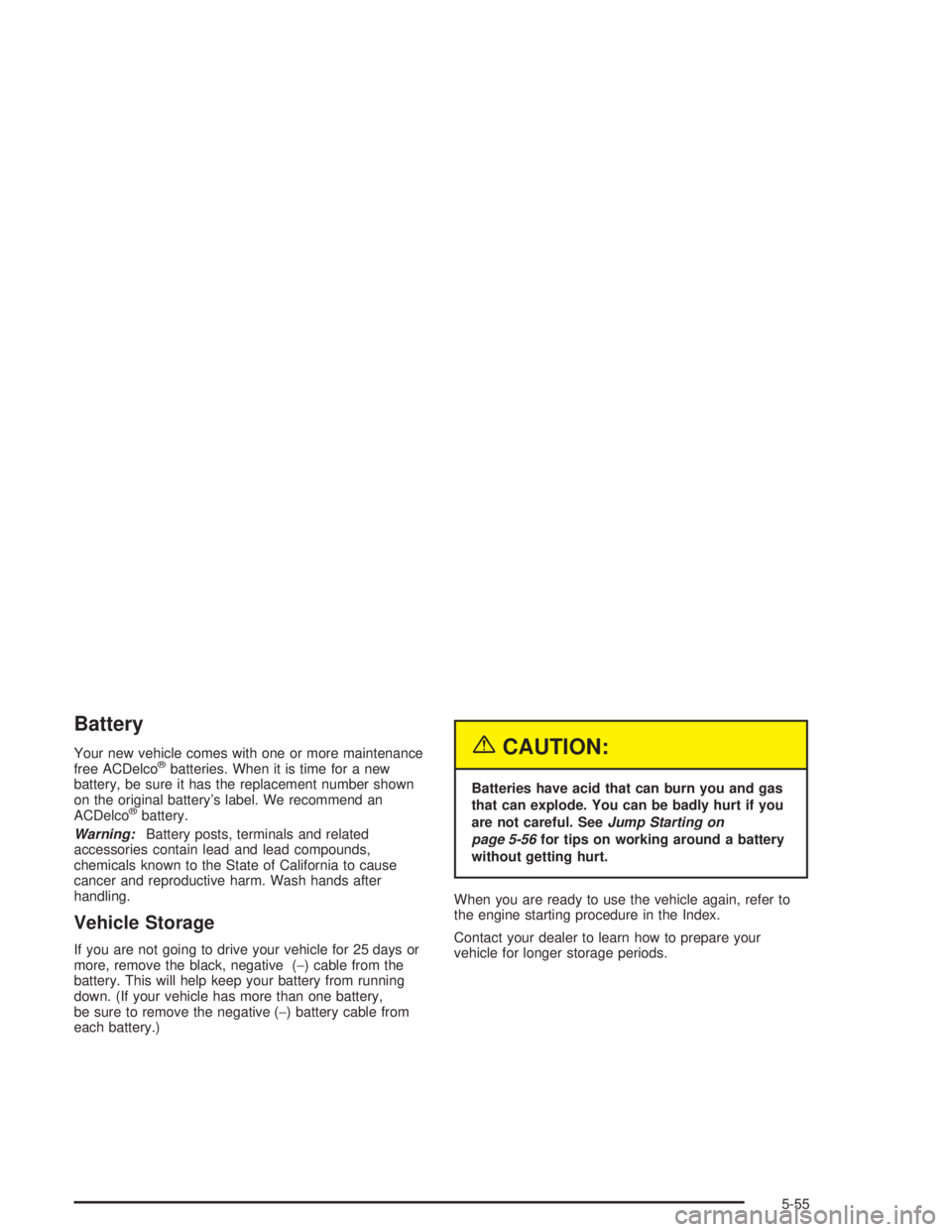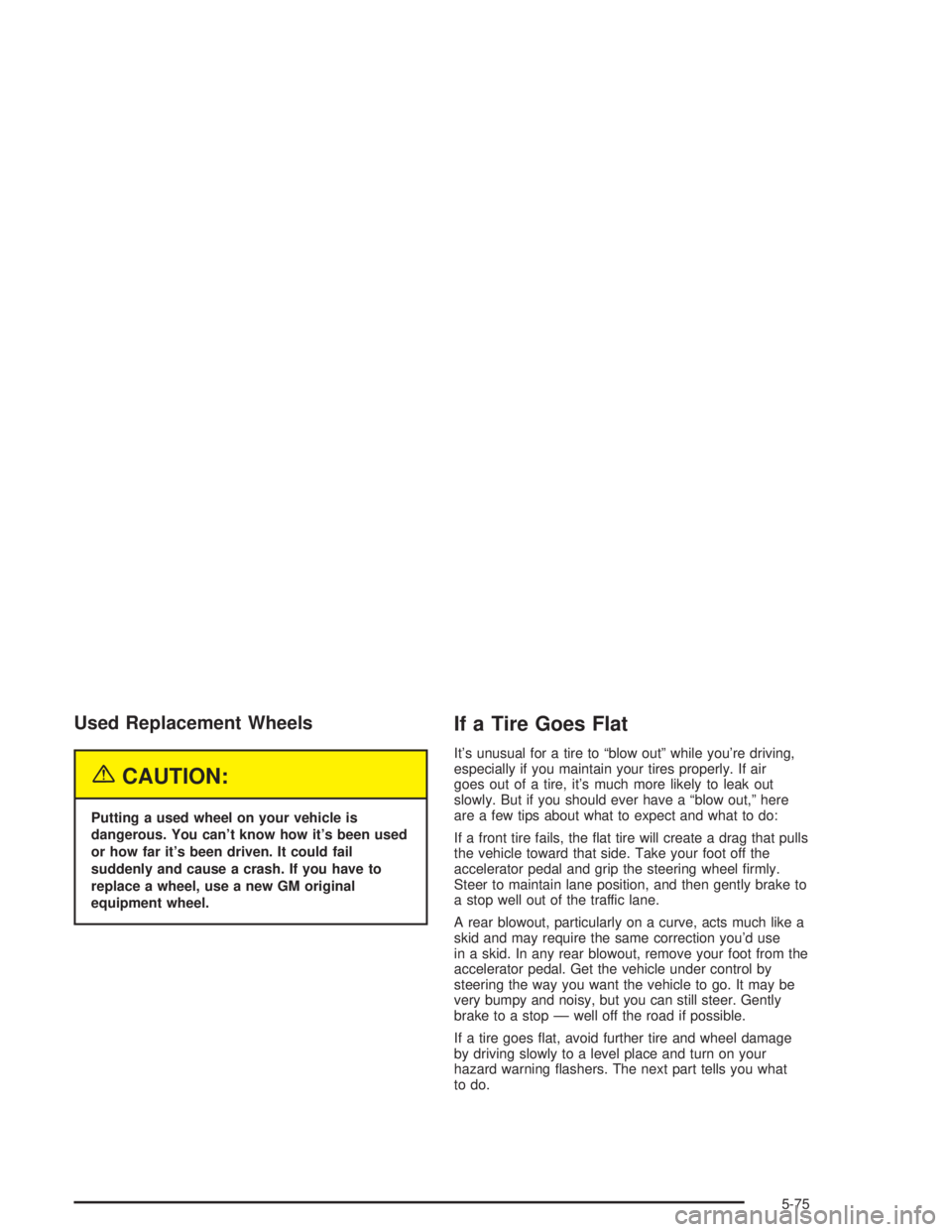Page 250 of 366

If your power steering fluid level is low, this can cause
the brake or service brake soon warning lights to
come on. In addition, the steering effort and emergency
brake distance could increase.
If either light remains on after you have added power
steering fluid to the proper level, then shut off the engine
for 10 seconds. This should reset the brake warning
lights. If one or both lights stay on though, see
“Hydraulic Brake System Warning Lights” underBrake
System Warning Light on page 3-31for more
information.
What to Use
To determine what kind of fluid to use, seePart C:
Recommended Fluids and Lubricants on page 6-29.
Notice:When adding power steering �uid or
making a complete �uid change, always use the
proper �uid. Failure to use the proper �uid can
cause leaks and damage hoses and seals.
Windshield Washer Fluid
What to Use
When you need windshield washer fluid, be sure to read
the manufacturer’s instructions before use. If you will
be operating your vehicle in an area where the
temperature may fall below freezing, use a fluid that has
sufficient protection against freezing.
Adding Washer Fluid
Your vehicle has a low
washer fluid light that lets
you know when to add
washer fluid.
5-44
Page 261 of 366

Battery
Your new vehicle comes with one or more maintenance
free ACDelco®batteries. When it is time for a new
battery, be sure it has the replacement number shown
on the original battery’s label. We recommend an
ACDelco
®battery.
Warning:Battery posts, terminals and related
accessories contain lead and lead compounds,
chemicals known to the State of California to cause
cancer and reproductive harm. Wash hands after
handling.
Vehicle Storage
If you are not going to drive your vehicle for 25 days or
more, remove the black, negative (−) cable from the
battery. This will help keep your battery from running
down. (If your vehicle has more than one battery,
be sure to remove the negative (−) battery cable from
each battery.)
{CAUTION:
Batteries have acid that can burn you and gas
that can explode. You can be badly hurt if you
are not careful. SeeJump Starting on
page 5-56for tips on working around a battery
without getting hurt.
When you are ready to use the vehicle again, refer to
the engine starting procedure in the Index.
Contact your dealer to learn how to prepare your
vehicle for longer storage periods.
5-55
Page 280 of 366

Wheel Replacement
Replace any wheel that is bent, cracked or badly rusted
or corroded. If wheel nuts keep coming loose, replace
the wheel. If the wheel leaks air, replace it.
Your dealer will know the kind of wheel you need.
Each new wheel should have the same load-carrying
capacity, diameter, width, offset and be mounted
the same way as the one it replaces.
If you need to replace any of your wheels, wheel bolts
or wheel nuts, replace them only with new GM
original equipment parts. This way, you will be sure to
have the right wheel, wheel bolts and wheel nuts
for your vehicle.
{CAUTION:
A leaking wheel could fail without warning.
A wheel designed for tubeless tires could be
leaking because it is damaged. Don’t use
an inner tube or some other thing to try to
stop the leaking. Get a new wheel or the
proper type.
{CAUTION:
Without the correct wheel, you may not be able
to stop properly, and you could have other
problems like a tire air-out. You could have a
collision. If you don’t go to your dealer to get a
new wheel, be sure you get the correct one.
Each new wheel should match the original
wheel in load-carrying capacity, in�ation
pressure capacity, diameter, width, offset and
mounting con�guration.
Using wheels and tires with higher load-carrying limits
than the original wheels and tires doesn’t change
the GAWR or the GVWR of your vehicle. See “Loading
Your Vehicle” for more information.
Notice:The wrong wheel can cause trouble in
bearing life, brake cooling, speedometer/odometer
calibration, headlamp aim, bumper height, vehicle
ground clearance, stopping distance and tire
clearance to the body and chassis. You could also
have other problems like a tire air-out.
5-74
Page 281 of 366

Used Replacement Wheels
{CAUTION:
Putting a used wheel on your vehicle is
dangerous. You can’t know how it’s been used
or how far it’s been driven. It could fail
suddenly and cause a crash. If you have to
replace a wheel, use a new GM original
equipment wheel.
If a Tire Goes Flat
It’s unusual for a tire to “blow out” while you’re driving,
especially if you maintain your tires properly. If air
goes out of a tire, it’s much more likely to leak out
slowly. But if you should ever have a “blow out,” here
are a few tips about what to expect and what to do:
If a front tire fails, the flat tire will create a drag that pulls
the vehicle toward that side. Take your foot off the
accelerator pedal and grip the steering wheel firmly.
Steer to maintain lane position, and then gently brake to
a stop well out of the traffic lane.
A rear blowout, particularly on a curve, acts much like a
skid and may require the same correction you’d use
in a skid. In any rear blowout, remove your foot from the
accelerator pedal. Get the vehicle under control by
steering the way you want the vehicle to go. It may be
very bumpy and noisy, but you can still steer. Gently
brake to a stop –– well off the road if possible.
If a tire goes flat, avoid further tire and wheel damage
by driving slowly to a level place and turn on your
hazard warning flashers. The next part tells you what
to do.
5-75
Page 282 of 366

Changing a Flat Tire
Your truck, when new, did not include tire changing
equipment or a place to store a tire in the vehicle. Few
drivers of these vehicles have the necessary equipment
aboard to be able to change a flat tire safely. For
example, you would need a truck jack that can lift
several thousand pounds and a torque wrench that can
generate several hundred foot-pounds (Y)of
twisting force.
{CAUTION:
If you try to put air back into a tire that has run
�at, even a tire that was quite low on air, the
tire can have a sudden air-out. This could
cause you to lose control of the vehicle and
have a serious crash. Don’t re�ll a �at or very
low tire with air without �rst having the tire
taken off the wheel and checked for damage.
So if you’re stopped somewhere by a flat or damaged
tire or wheel, you should get expert help. SeeRoadside
Assistance Program on page 7-4.
{CAUTION:
Your vehicle, when new, did not include tire
changing equipment or a place to store a tire
in the vehicle. Special tools and procedures
are required if a tire needs to be serviced. If
these tools and procedures aren’t used, you
others could be injured or killed while trying to
change or service a truck tire.
Appearance Care
Remember, cleaning products can be hazardous. Some
are toxic. Others can burst into flames if you strike a
match or get them on a hot part of the vehicle. Some are
dangerous if you breathe their fumes in a closed
space. When you use anything from a container to clean
your vehicle, be sure to follow the manufacturer’s
warnings and instructions. And always open your doors
or windows when you are cleaning the inside.
5-76
Page 295 of 366
Fuse Usage
RH PARK LP Right-hand Parking Lamps
LH PARK LP Left-hand Parking Lamps
RADIO U Radio
PWR WINDOW Power Windows
BRAKE ISO Brake Warning Lamp
SPARE Spare Fuse
L-RR TRUCK Left Rear Trailer Wiring
SPARE Spare Fuse
SPARE Spare Fuse
SPARE Spare Fuse
R-RR TRUCK Right Rear Trailer Wiring
SPARE Spare Fuse
Relay Usage
BRAKE LAMPC4/C5 Brake Lamps,
C6/C7/C8 Tractor/Trailer Wiring
IGN 4 IgnitionRelay Usage
MARKER LP Sidemarker and Clearance Lamps
HTD FUEL LB7/LG4 Heated Fuel
AIR HTR LG4 Air Heater
ECU MAINTAIN LG4 Electronic Control Unit
DRL Daytime Running Lamps
CHMSL ISO Center High Mounted Stop Lamp
HTD MIRR Heated Mirrors
R-TRN TLR Right Trailer Turn Signal
L-TRN TLR Left Trailer Turn Signal
SPARE Spare Relay
SPARE Spare Relay
SPARE Spare Relay
5-89
Page 296 of 366
Circuit Breaker Usage
1 Stoplamps
2 Center High Mounted Stop Lamps
3 Parking Lamps
4 Powertrain Control Module
5 Auxiliary Wiring
6 Heater/Air Conditioning
7 Hazard Warning FlashersCircuit Breaker Usage
8 Power Post
9 Courtesy Lamps
10Warning Lights, Gages and
Indicators
11 Crank
12 Rear Axle
13Trailer Turn Signals/Hazard Warning
Flashers
14 Radio/Chime
15 Daytime Running Lamps
16 Air Bag System
17 Exterior/Interior Lamps
18 Parking Brake
19 Accessory Power
20 Ignition
21 Sidemarker Lamps
22 Turn Signal/Backup Lamps
23 Transmission
24 Chassis
A Spare
B Spare Fuse Block 2
5-90
Page 299 of 366
Fuse Usage
IGN 1 Ignition 1
IGN 4 Ignition 4
IGN 3 Ignition 3
BATT/HAZ Battery/Hazard Warning Flashers
HEADLAMP Headlamps
LIGHTING Interior/Exterior Lamps
HVAC Comfort Control System
NOTE C4/C5 Electric Brake,
C6/C7/C8 Brake Lamps
Capacities and Speci�cations
Capacities and Speci�cations
Engine RPO
7.2L L6 HEUI Fuel System LG5
8.1L V8 SPFI Fuel System L18
7.8L L6 Common Rail Fuel System LG4
6.6L V8 Common Rail Fuel System LB7/LLY Secondary Underhood
Fuse Block
5-93